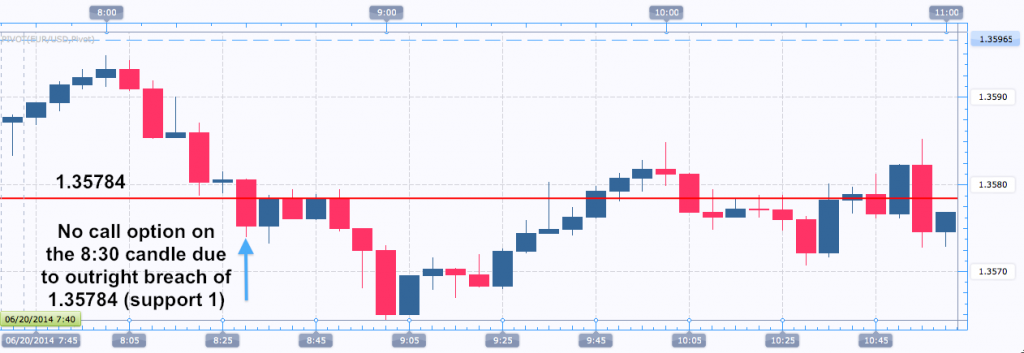EUR/USD Trading for June 20, 2014
As I stated in my last post, I am trading at Boss Capital at the moment. I do like how you can obtain an 85% payout for an in-the-money trade. That’s really as low as I prefer to go with binary trades in terms of payout percentages. Having a lower break-even percentage is nice. At an 85% ITM payout, you would need to win 54% of your trades just to keep an even account balance, assuming fixed-investment money management (i.e., putting the same amount of money into each trade). But most conspicuously, your profit margin will stay higher, which is even more important especially the more advanced you become. You can always see the possible combinations via this spreadsheet I posted to the forum:
As for Friday’s trade, the EUR/USD was in a slight downtrend for the day once I began watching the chart at around 7:30AM EST. Price was lingering down toward the support 1 line on my chart (1.35784).
When markets downtrend and a pivot point (or major Fibonacci level) are nearby, price will usually touch them. Throughout my trading experience, it’s been something I’ve been able to rely upon frequently. The same goes for basic support and resistance levels created from previous price history to some extent. Enough money drives the price of an asset to these levels, so they tend to be touched. Many limit orders are placed around these support and resistance levels in the market. Sometimes they will act as reversal points in the market. And sometimes they will be breached entirely. It’s really all up to your ability to read and interpret price action to determine if a trade set-up is viable or whether to pass on it altogether.
Of course, my recommendation is to never trade just the level. Always look for some sort of confirmation to ensure that the level actually appears as if it’ll hold before taking such a trade. For me, that involves a rejection and some sort of observable hesitation once price reaches that level. I don’t have any cut-and-dried “rules” when it comes to trading, but I do talk a lot about the touch-reject-retouch price action “rule” a lot here in my blog as the basis for entering into trades and something I’ve used to regularly achieve a pretty high in-the-money percentage when it comes to short-term binary trades.
In this market I wanted to wait until price hit support 1 (1.35784). When it did, it actually touched and closed beneath the level instead of rejecting it on the 8:30(AM EST) candle. Since it didn’t reject it, I disqualified this as a place to take call options, given I no longer expected the Euro to make gains against the U.S. dollar in the short-term (i.e., increase in value on the chart).
However, that didn’t necessarily disqualify potential put options from setting up. If I was able to obtain some sort of move below support 1 only to have it come back up to touch 1.35784 in the future, a put option could be a possibility.
The Euro fell another fifteen pips against the USD after the breach of support 1 at 8:30. But by the 9:35 candle, the Euro had erased its losses and was back up challenging 1.35784 again, which had definitely shown some sensitivity as a potential turning point in the market an hour previously. Once it reached up to touch support 1, it was met by a swift rejection. Of course, I like that, so once it re-touched I was ready and willing to enter into a put option at 1.35784 should it touch there again soon.
I did not get the re-touch on the 9:40 candle, but I did on the 9:45. So I entered into the put option at 1.35784. Depending on how your fill is with the broker (i.e., the price you’re able to get in at) and the discrepancy between the bid/ask price, it’ll be tough to get in exactly where you need to, but all you can do is hope for the best.
Once I got into the trade, however, I didn’t quite get the subsequent rejection that I expected. I was only up by a fraction of a pip very briefly, but more or less price hung above my entry until expiry and I wound up with a three-pip loss.
Even so, I can’t discount losing trades or losing days as failures. I followed my strategy perfectly by only trading what I could with respect to following my personal trading preferences. And I could even take solace in the fact that I had the general idea of the trade right. Price did hang around my entry and fell back down about 5-10 minutes after expiry, but the sensitivity to that general zone of resistance didn’t really hit its ceiling until a few pips higher than where I entered.
In all, it was an 0-for-1 day. But I never ever feel down about losing trades, and of course I never commit the rookie mistake of trying to win back anything I lost, which many folks do to the point of entering completely random trades. But if you have a strategy that works and has been shown to work over several months/years and over the course of several hours/days/weeks of price data, you really don’t have anything to fear and it’s much, much easier to keep one’s emotions in check.


